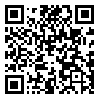BibTeX | RIS | EndNote | Medlars | ProCite | Reference Manager | RefWorks
Send citation to:
URL: http://jdisabilstud.org/article-1-1179-fa.html

 ، حمزه اکبری*1
، حمزه اکبری*1 
 ، حسن صاﺋمی1
، حسن صاﺋمی1 

چکیده
زمینه و هدف: علائم روانشناختی مانند استرس و اضطراب و افسردگی بهعنوان اختلالهای شایعتر روانپزشکی، در والدین سبب بروز علائم روانشناختی منفی در فرزندان میشود؛ همچنین این عاملها در آینده بر عملکرد شخصی و اجتماعی افراد تأثیر منفی میگذارد. هدف این پژوهش بررسی رابطهٔ بین عاطفهٔ مثبت و عاطفهٔ منفی و تعارضات ادراکشدهٔ والدین با علائم روانشناختی دانشآموزان مقطع متوسطهٔ اول بود.
روشبررسی: روش پژوهش توصیفی از نوع همبستگی بود. جامعهٔ آماری این پژوهش تمامی دانشآموزان مقطع متوسطهٔ اول شهرستان آزادشهر در سال تحصیلی ۹۷-۱۳۹۶ (۳۵۴۰=N) بودند. با استفاده از جدول کرجسی و مورگان (۱۹۷۰) حجم نمونه ۲۴۶ نفر برآورد شد و با استفاده از روش نمونهگیری خوشهای اعضای نمونه انتخاب شدند. برای جمعآوری دادهها، پرسشنامهٔ عاطفهٔ مثبت و عاطفهٔ منفی (واتسون و همکاران، ۱۹۸۸) و مقیاس تعارض ادراکشدهٔ والدین (گریج و همکاران، ۲۰۰۴) و پرسشنامهٔ سنجش علائم روانشناختی (لویبوند و لویبوند، ۱۹۹۵) بهکار رفت. دادهها بهکمک روش تحلیل رگرسیون چندمتغیری، ضریب همبستگی پیرسون و آزمون تی مستقل در نرمافزار SPSS تحلیل شدند. سطح معناداری آزمونهای آماری ۰٫۰۵ در نظر گرفته شد.
یافتهها: ضرایب متغیرهای عاطفهٔ مثبت (۰٫۰۰۳=p) و عاطفهٔ منفی (۰٫۰۰۱>p) و ادراک از تعارض والدینی (۰٫۰۰۱>p) در مدل رگرسیون معنادار بود. رابطهٔ بین عاطفهٔ مثبت و علائم روانشناختی دانشآموزان (۰٫۳۹۵-=r) منفی و معنادار (۰٫۰۰۱>p) و رابطهٔ بین عاطفهٔ منفی و علائم روانشناختی دانشآموزان (۰٫۴۵۶=r) مثبت و معنادار (۰٫۰۰۱>p) و رابطهٔ بین تعارضات ادراکشدهٔ والدین و علائم روانشناختی دانشآموزان (۰٫۴۱۰=r) مثبت و معنادار بود (۰٫۰۰۱>p). همچنین تفاوت میانگین نمرات علائم روانشناختی (۰٫۰۰۱>p) و افسردگی (۰٫۰۱۷=p) و اضطراب (۰٫۰۳۹=p) دانشآموزان دختر و پسر متفاوت و معنادار بود.
نتیجهگیری: براساس یافتههای پژوهش، تعارضها و بیشتر خصومتهای شدید و فراگیر و آشکار بین والدین، دارای عوارض منفی بر کودکان است؛ بهعبارتی، محیط امن عاطفی خانواده بهعنوان عاملی مهم، در کاهش مشکلات هیجانی کودکان در زمینهٔ کشمکشهای والدین نقش دارد.
| بازنشر اطلاعات | |
 |
این مقاله تحت شرایط Creative Commons Attribution-NonCommercial 4.0 International License قابل بازنشر است. |




